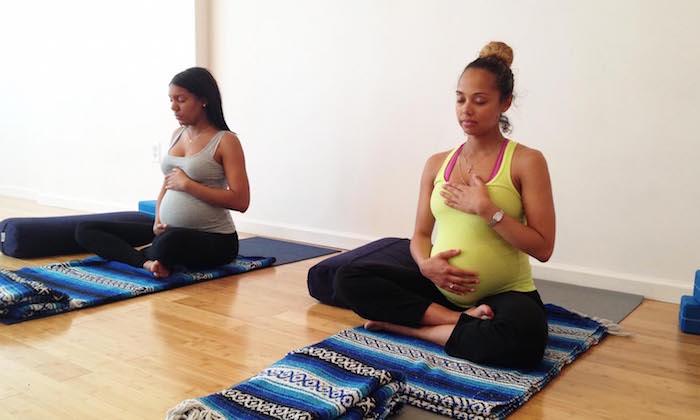
Our expert tells you everything you ever wanted to know about prenatal yoga, whether you’re a total novice or a wizened yogi!
‘Prenatal yoga’ is one of the most-searched terms on our pregnancy site, but we’d never want to advocate or recommend something without providing lots of context to ensure your looking after your body and precious bump, mama! With that in mind, we turned to prenatal yoga expert Gwen Thornhill of Yoga Therapy to cover everything from prenatal yoga’s amazing benefits, to exercises even advanced yogis should avoid during pregnancy. Get ready for a truly enlightening read, mamas!
If you’ve never done yoga before, is it safe to do prenatal yoga?
It is absolutely safe to practice prenatal yoga without prior experience as the poses introduced during a pre-natal yoga class differ from that of a typical hatha/vinyasa class and are less intense. Classes are designed to create a nurturing environment and to foster connection with your baby; which is done through restorative poses, relaxation and breathing exercises. Additionally, pre-natal yoga prepares you for labour and childbirth; for example though pelvic floor exercises, squats, belly breathing to name a few.

If you’re already doing yoga, how do you adjust when you’re pregnant?
If you had a regular practice for at least one year before being blessed with pregnancy, you can maintain your yoga practice but bear in mind that pregnancy is not the time to conquer new advanced poses or push your limits. There are also certain poses to avoid during pregnancy such as inversions, prone poses, closed twists, and supine poses (as the womb enlarges), deep backbends and hand-balancing poses. However the general guide is to listen to your body and stay within its comfortable boundaries. Every week your body changes, whether it is hormones causing you to feel more exhausted, or your extra fluids at late pregnancy causing feet and ankles to swell.
For example, your growing belly can throw you off balance; one week when you are practising the Tree pose effortlessly, the next week you might feel unstable; so for balance poses, ensure you are standing right next to a wall. And for any flow sequence, adopt a widened stance.
It is also important to stay away from poses that compress the abdomen. Deep and closed twists are contraindicated during pregnancy. Instead, do open twists and focus on isolating the twist to the upper back, or “above the bra strap”. It is also essential to avoid abdominal toning, instead we focus on the transverse abdominals during prenatal yoga (i.e. the deepest abdominal muscles that wrap around your spine and provide stability).
During pregnancy, an increased supply of progesterone causes a rise in the hormone relaxin, which softens your connective tissue to prepare for childbirth. As a result, your ligaments and joints become more flexible, and you may find your body more pliable during pregnancy. Care should be taken not to overextend in any stretch or pose, as this can stress the muscles or lead to pelvic and joint instability or even pulled ligaments (which take a long time to heal). You should also avoid breathing patterns that require breath holding or upper abdominal locks.

How often should you do prenatal yoga?
As often as your schedule allows! Sessions are designed to strengthen and stretch the muscles to prepare you for labour, and a large portion of class is dedicated to relaxation and breathing. Mothers who feel tired, or experience morning sickness, work instead on meditation and restoration. It is crucial for the pregnant woman to listen to her body and respect when she feels like exercising and when she just needs to unwind and relax. Encouragement is also given for mothers to develop their own private practice which they can do on a daily basis.
Is there anyone you wouldn’t recommend do prenatal yoga?
If you are experiencing any health conditions such as preeclampsia, placenta previa, low iron levels, gestational diabetes or pubis symphosis dysfunction, it is important to get the go-ahead from your obstetrician and keep an open dialogue with your yoga teacher so she can be aware of your condition and modify/tailor the sessions to support your specific needs. Also, be mindful if there are any concerns about fetal health.

What are the general benefits of doing prenatal yoga?
The classes are intended to recognise the requirements and constraints of pregnancy. Studies have suggested that practising yoga during this period can improve sleep, reduce stress and anxiety, alleviate discomfort associated with acid reflux, abdominal bloating and sacroiliac issues, and finally increase strength, flexibility and endurance of muscles needed for childbirth. As with any other yoga pursuit, you will also feel a general sense of wellbeing after class.
How does prenatal yoga help with birth/labour/post-labour recovery?
Expanding from above, prenatal yoga helps to prepare you for labour — for example in a deep squat pose (Malasana). This works on releasing tension throughout the hips, lower back and ankles. Squats also elongate your spine, stretch your legs, improve your balance and strengthen your core muscles. In fact, in many cultures the squatting position is a very common labour and birthing position as it widens the pelvis and makes more room for the baby’s head to emerge. Your prenatal yoga instructor will guide you through safely entering and exiting the pose, and approach it in a gentle way depending on your level of flexibility.
A large part of prenatal yoga is the relaxation and breath work, which I can personally attest to helping me through two natural births.

When should I start prenatal yoga?
It is generally recommended after the first trimester, or at around 14 weeks; after being given the go-ahead by your obstetrician. The first trimester holds the highest risk for miscarriage, and many women feel rather drained, experiencing morning sickness during the first three months as there is a lot happening inside; after all, the body is assembling a life support system for the baby!
Help! I feel so unattractive, clumsy and foggy-brained!
Being pregnant is like a yoga practice in itself! You start practising non-attachment for those months with things such as a once fit/toned/svelte body, favourite foods which now disagree with your digestion, and a full night of uninterrupted sleep! You also acknowledge your responsibility to the human being growing inside you, which calls for a sense of selflessness. Instead of focusing primarily on the physical, many find their exercise become more internal as they progress through pregnancy. A large part is about accepting and surrendering, and letting go of something you had aspired to and are proud of, and welcome that it is no longer just about you anymore.
How far into my pregnancy can I practise prenatal yoga?
Right up to birth! In fact many prenatal yoga poses are recommended for use during labour. On top of which, putting into practice the deep breathing learnt during classes helps tremendously with pain management.
 View All
View All


 View All
View All


 View All
View All

 View All
View All
 View All
View All


 View All
View All








